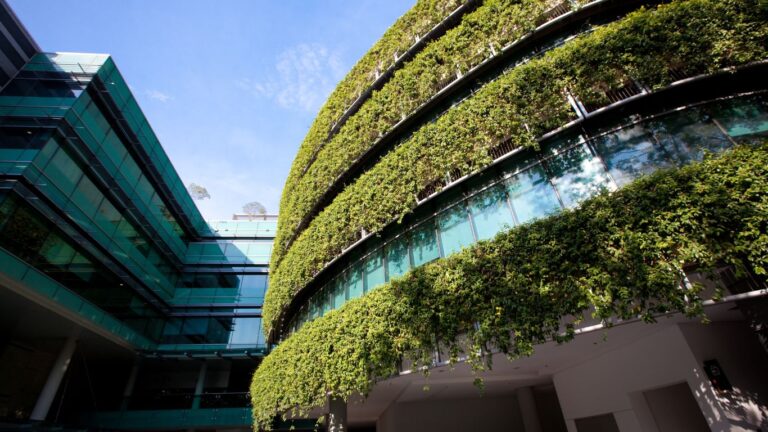
Life Cycle Assessment Services ,Environmental Sustainability Services, Carbon Footprint Services, Environmental Impact Assessment Services, Sustainability Report Services, Environmental Product Declaration Services, Green Technology Services, Lifestyle For Environment Services, Measuring Carbon Footprint Services, Green Building Certification Services, Environmental Audit Services , Water Footprint Services

India’s Green Building Rating Systems: The Best Green Certification for Your Next Project
The Need for Sustainable Construction in India
The construction industry in India is undergoing a paradigm shift towards sustainability. As the world grapples with the effects of climate change, the demand for energy-efficient, resource-conserving buildings is growing rapidly. Green building certifications play a pivotal role in this transformation, ensuring that buildings are designed and constructed with environmental responsibility in mind.
With multiple certification options available in India, it’s essential for developers and project managers to understand the best fit for their projects.
Whether it’s a residential building or a large-scale commercial development, the right green building certification can significantly impact long-term value and operational performance.
Why Green Building Certifications Matter
Green building certifications are much more than a marketing tool—they are a commitment to sustainable development. These certifications provide a framework for measuring a building’s environmental performance in key areas such as:
- Energy Efficiency: Reducing energy consumption and reliance on non-renewable energy sources.
- Water Conservation: Implementing efficient water management practices to minimize waste.
- Indoor Environmental Quality: Ensuring a healthy and comfortable indoor environment for occupants.
- Sustainable Materials: Prioritizing eco-friendly materials that reduce the carbon footprint.
Green certifications not only ensure compliance with environmental regulations but also lead to significant cost savings over time, enhancing the marketability and resale value of buildings.
India’s Leading Green Building Certification Systems
India is home to several green building rating systems, each catering to different types of projects. Here are the key certifications:
1. LEED India (Leadership in Energy and Environmental Design)
LEED India, adapted from the US Green Building Council’s framework, is one of the most globally recognized green building certification systems. It evaluates energy performance, water conservation, and indoor environmental quality, offering a comprehensive approach to sustainability.
2. GRIHA (Green Rating for Integrated Habitat Assessment)
Launched by TERI and the Ministry of New and Renewable Energy, GRIHA is India’s national green building rating system. It addresses key sustainability factors such as energy performance, water management, and resource conservation, offering a holistic approach to sustainable building practices.
3. BEE Star Rating
Introduced by the Bureau of Energy Efficiency, the BEE Star Rating focuses specifically on the energy efficiency of commercial buildings. It is a voluntary rating system that evaluates energy consumption and promotes energy-saving measures.
4. GEM (Green and Ecofriendly Movement)
Developed by ASSOCHAM, GEM focuses on promoting sustainability throughout a building’s lifecycle, aligning with India’s national building codes and energy conservation standards. It supports eco-friendly practices in design, construction, and operation.
5. IEP (Integrated Energy Policy)
Though not a certification, the IEP outlines India’s roadmap for energy conservation and the integration of renewable energy sources, providing a policy framework for sustainable building practices.
How to Choose the Right Certification for Your Project
Choosing the right certification depends on several factors, including the type, scale, and goals of your project. Here’s a simple guide to help you make the right choice:
1. Project Type
- Residential: If you’re working on a residential project, GRIHA is often the best fit due to its focus on energy, water, and resource conservation.
- Commercial: For energy-efficient commercial buildings, LEED India and BEE Star Rating are ideal, as they emphasize energy savings and sustainable design.
2. Project Scale
- Large-Scale Developments: For large infrastructure projects, GRIHA and GEM are better suited, as they cover sustainability across the building’s lifecycle.
- Smaller Projects: Smaller-scale projects may benefit from BEE Star Rating, which offers a simpler path to certification while focusing on energy efficiency.
3. Location and Climate
Different certifications may be better suited to certain climates and geographies. For instance, GRIHA provides flexible criteria for various regions of India, while LEED India is often used for urban commercial projects.
4. Budget and Financial Considerations
Initial certification costs can vary, so it’s important to assess whether the long-term savings (through reduced energy costs and government incentives) outweigh the upfront investment. Green certifications often result in higher tenant demand and better resale value.
5. Government Incentives
Some certifications, like GRIHA and BEE Star Rating, offer additional benefits such as government rebates and financial incentives, further driving down project costs.
Prime Examples of Certified Green Buildings in India
To help illustrate the impact of green building certifications, consider these successful examples of sustainable buildings in India:
1. DLF Cyber Hub, Gurgaon (LEED Platinum)
This commercial office complex is a prime example of how LEED India certification enhances a building’s energy performance and environmental responsibility. It serves as a model for energy-efficient office spaces in urban environments.
2. Pimpri Chinchwad New Town Development Authority, Pune (GRIHA)
This residential development is a strong case for GRIHA certification, focusing on resource conservation, energy efficiency, and water management to create sustainable urban housing solutions.
3. CII Sohrabji Godrej Green Business Centre, Hyderabad (LEED Platinum)
One of India’s most renowned green commercial buildings, this center demonstrates how LEED India certification drives significant energy savings and promotes sustainability in business operations.
4. Palladio Apartment Complex, Pune (GRIHA)
A large-scale residential project that has earned GRIHA certification for its emphasis on sustainable construction practices, energy savings, and water conservation throughout the building lifecycle.
Green Building Certifications: A Strategic Move for the Future!
As demand for sustainable buildings rises, green certifications are more essential than ever. They help developers comply with regulations, enhance environmental performance, and provide long-term financial and operational benefits.
Choosing the right certification boosts energy efficiency, reduces costs, and enhances market reputation. For residential, commercial, or large-scale projects, embracing green building principles is a key step towards a sustainable future in India.